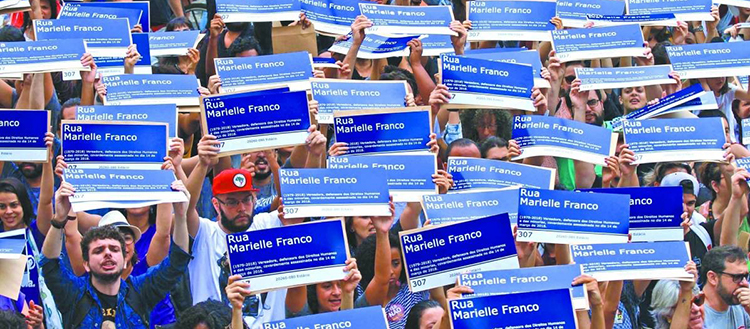New UNESCO chair in inclusive toponymy “Naming the World”
An international, UNIGE-led team will work on place naming on a global scale with a particular focus on gender, the visibility of minorities and sustainable development.

Countless reproductions of the Street Plaque named after murdered deputy Marielle Franco are held up by protesters in Rio de Janeiro in October 2018, after the original plaque was destroyed by elected officials from the ruling far-right party. © José Lucena/Futura Press
How are places named around the world? Who names them? And what political, cultural, social and memory issues are at stake? A new UNESCO chair in inclusive toponymy, “Naming the World”, is launched at the University of Geneva (UNIGE), Switzerland, to adress theses issues. What are its goals? To highlight the conundrum of place naming, which is becoming increasingly prevalent; to explain the mechanisms that lie behind it; to create a space for dialogue between academics, civil society, and public and private operators; and to draw up an inventory of good practices and recommendations. Although toponymy is seemingly only a sub-branch of linguistics, it raises a number of problems, such as the question of gender, the visibility of minorities, indigenous languages and knowledges, unformal settlements and the relationship to colonisation. Over the next four years, UNIGE will start up a network of partnerships based around the new chair, in particular with Africa and Europe for academic networks, and with international organisations.
Traditional toponymy is the study of the origins and meanings of place names and how they evolve over time. “Toponymy can be also used in the archaeological reconstruction of settlements and the relationship to the environment in the past”, says Frédéric Giraut, a professor in UNIGE’s School of Social Sciences and director of the UNESCO chair in inclusive toponymy. “Just recently, German archaeologists discovered the oldest known place name sign in Upper Egypt that dates back to 4000 BC!”.
Gender issues and the visibility of minorities
At the same time, toponymy is not just about explaining place names signification. Important questions are raised by studying the contemporary production of names, which shapes the visibility of certain memories and symbols in the public space as well as signage, mapping and addresses. “We talk about inclusive toponymy”, continues Professor Giraut, “because the issue of gender is self-evident, with women being under-represented in marking public spaces, just as minorities can be when it comes to marking space in general, whether in the West or countries with a colonial past.” Accordingly, the research by the UNESCO Chair partners will centre on the representation of different memories, heritages, cultures, and social and spatial visions by fostering debate between academics, civil society and operators via a series of forums. “We’ll also look at controversial commemorations and claims by analysing the terms of the debate in their historical, social and ethical dimensions”, adds the Geneva-based researcher. It follows that the chair will focus on questions that touch on collective memories and their possible inconsistencies. Can different memories be present simultaneously – and, if so, how? These problems, which are found in very different contexts and on very different scales, relate to the choice and recognition of languages together with historical, cultural and political references.
Official toponymy versus vernacular toponymy
Another subject raised by the UNESCO chair in inclusive toponymy is addressing. “Mainly in so-called developing countries, entire districts are built independently of any official authority, which tries retrospectively to organise these ‘informal settlements’ using a tracing system based on numbering plots and street names”, points out Professor Giraut. But this approach collides with a vernacular organisation which uses its own names for everyday landmarks, creating a tension between public policy and the residents of the districts and increasing antagonistic systems.
More generally, this examination of official policy will be an opportunity to analyse what names are chosen and why, in particular regarding the commodification of certain place names that are sold or rented, or place branding. It will range from observing the contemporary process of naming to retrospective analysis using different types of sources involving mapping, archives, the press or geographic information systems.
The shift in mapped toponymy from the public to the private sphere
There is no such thing as toponymy without mapping. “Detailed mapping used to be performed by state authorities, first military and then civilian. Private actors, such as the behemoth Google or on-board GPS companies, later established themselves as major references for users”, notes Professor Giraut. In addition, there is participatory mapping, where everyone can contribute to the detailed mapping of the world, notably thanks to OpenStreetMap. These different geographic information systems all act as world mappings, sometimes conflicting with one another, as Professor Giraut further explains: “The advantage of these ‘unofficial’ maps, with their very widespread uses, is that they allow informal districts to spring up that are invisible on state maps, thereby promoting vernacular, alternative toponymies.”
An international partnership
To address these matters, an academic consortium will be assembled, starting with the formalisation of an existing network on two scales: global – bringing together specialists and their teams on every continent together with interested international organisations; and African – with the launch of an observatory of African neotoponymy (the naming of new geographical objects), including a platform for dialoguing with practitioners and experts. The programme for the chair will also incorporate the production of a French and English twin-edition manual and an online course: Naming the World.
The decision to award UNIGE the candidacy for a new UNESCO chair is designed to validate the claims of this emerging field, where the cultural, heritage and development subjects are in line with the founding themes of the international organisation. Likewise, the positioning of the chair is consistent with a number of UNESCO’s priorities, in particular gender issues; the North-South academic and technical partnership, especially with Africa; and the inclusion of cultural aspects, including indigenous and vernacular knowledge, in sustainable development initiatives.
